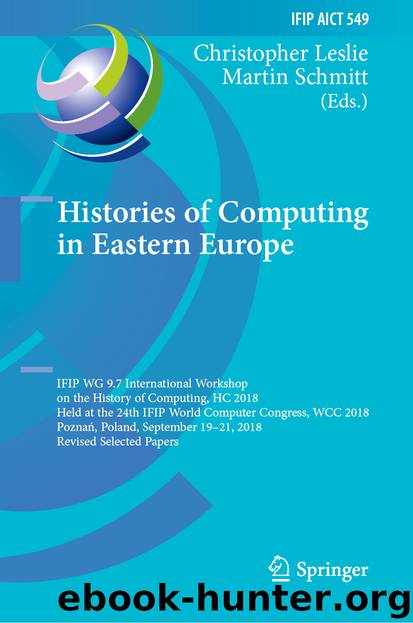Histories of Computing in Eastern Europe by Christopher Leslie & Martin Schmitt

Author:Christopher Leslie & Martin Schmitt
Language: eng
Format: epub
ISBN: 9783030291600
Publisher: Springer International Publishing
6 Second Path: Learning from USSR and Cooperation in Comecon: 1960s to 1970s
Up to the late 1950s, there was almost no activity in Warsaw and Moscow regarding the interchange of experiences and knowledge on computers [43].
USSR assistance to the computer industry turned out to be necessary only starting from the moment of transition from the first to the second generation of computers, i.e., transistors, in the late 1950s. Everything seems to indicate that the opening of the Elwro factory was the domestic work of the government of the People’s Republic of Poland and Polish engineers. However, with the transition to semiconductor technology, consultations with the Russians have proved necessary. In the years 1960–1964 a number of contracts for the supply of semiconductor products and semiconductor technologies from the USSR to the PPR were signed up on behalf of the PPR by the enterprise PHZ Polimex and on behalf of the USSR by Tiaazhpromexport. In addition to selling materials, the USSR offered advice at the preparatory stage of assembly lines for manufacturing germanium and silicon transistors by Poland [44, 45]. It was the TEWA Semiconductor Factory in Warsaw, the second in importance in Poland after the Elwro plant, that was entrusted with the implementation of semiconductor components. In the first half of the 1960s, the production of germanium diodes and transistors was mastered there, and preparation for the production of silicon diodes and transistors was successfully launched.
Experts were also consulted with respect to the production of raw materials. The factory Aluminum Works in Skawina was producing polycrystalline germanium from germanium dioxide imported from western countries. TEWA itself was producing monocrystalline germanium. On the other hand, work was underway on launching production of high resistance polycrystalline silicon at the nitrogen plant in Tarnów. The targeted production capacity of Tarnów was to reach 5.9 tons per year in 1967. This was even higher than the forecasted demand for this intermediate product until 1970 (Fig. 2).
Fig. 2.In the 1980s, the Polish computer industry was able to export remarkable quantities of minicomputers to Comecon and especially to the Soviet markets, as in case of MERA minicomputers of series 60 manufactured in Silesia.
Photo courtesy Piotr Fuglewicz.
Download
This site does not store any files on its server. We only index and link to content provided by other sites. Please contact the content providers to delete copyright contents if any and email us, we'll remove relevant links or contents immediately.
Algorithms of the Intelligent Web by Haralambos Marmanis;Dmitry Babenko(8529)
Test-Driven Development with Java by Alan Mellor(7438)
Data Augmentation with Python by Duc Haba(7330)
Principles of Data Fabric by Sonia Mezzetta(7076)
Learn Blender Simulations the Right Way by Stephen Pearson(7018)
Microservices with Spring Boot 3 and Spring Cloud by Magnus Larsson(6834)
RPA Solution Architect's Handbook by Sachin Sahgal(6248)
Hadoop in Practice by Alex Holmes(6038)
The Infinite Retina by Robert Scoble Irena Cronin(5952)
Jquery UI in Action : Master the concepts Of Jquery UI: A Step By Step Approach by ANMOL GOYAL(5878)
Big Data Analysis with Python by Ivan Marin(5742)
Life 3.0: Being Human in the Age of Artificial Intelligence by Tegmark Max(5410)
Pretrain Vision and Large Language Models in Python by Emily Webber(4701)
Infrastructure as Code for Beginners by Russ McKendrick(4481)
WordPress Plugin Development Cookbook by Yannick Lefebvre(4213)
Functional Programming in JavaScript by Mantyla Dan(4129)
The Age of Surveillance Capitalism by Shoshana Zuboff(4124)
Embracing Microservices Design by Ovais Mehboob Ahmed Khan Nabil Siddiqui and Timothy Oleson(4003)
Applied Machine Learning for Healthcare and Life Sciences Using AWS by Ujjwal Ratan(3980)
